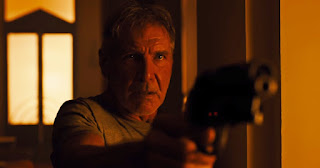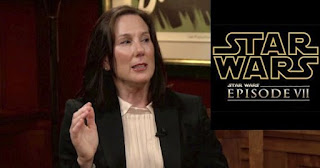Like so many folks, I had theories about what would logically follow the events of The Force Awakens, and even had some ideas that ran contrary to all of those “Rey MUST be Luke’s daughter” stuff some people blathered on and on about. Now, however, I sit here after my initial viewing of The Last Jedi (“initial,” because I already have tickets for two more showings in the next few days) wondering exactly what to say about it. Not because I’m wondering if I liked it - quite the contrary, I most certainly did. I’m just a bit stumped about what to say because The Last Jedi actually surprised me so.
The first thing that pops to mind is that it sure seems to me that writer/director Rian Johnson was given LOADS more freedom to take this story where he wanted than J.J. Abrams was for the prior film. For those of you who complained that The Force Awakens followed too many story beats from the original 1977 film, you darn-sight shouldn’t have any gripes about this one being too much like The Empire Strikes Back. The opening crawl sets us up by telling us that the First Order is on the ascent across the galaxy, having run down General Leia’s Resistance to just a few hundred ships and personnel, and are closing in for the final kill. While the remnants of the Resistance fleet flees from General Snarky-Pasty-Face… excuse me, I mean General Hux (Domhnall Gleeson)… our heroes are split off on separate missions that will hopefully all serve the same goal - escape Hux’s pursuit without being tracked to a new hideout. While Poe Dameron (Oscar Isaac) grows impatient about the seemingly risk-averse approach charted by Leia and her second-in-command (Laura Dern), John Boyega’s Finn teams up with a Resistance mechanic named Rose (Kelly Marie Tran) to track down a hacker (“codebreaker”) to sabotage the First Order’s new ability to follow the rebel ships in and out of light speed.
Simultaneously, Rey (Daisy Ridley) is right where The Force Awakens left her - on the island-dotted planet of Ahch-To, where she found Luke sulking in the remains of an ancient Jedi temple. While hounding him to not only return to action, but also tutor her in the ways of the Force, she learns about why Luke ended up here and comes to find just how much raw power she may possess. The dynamic between Luke and Rey feels similar to that of Yoda and Luke in Empire at first, but the payoff to which it leads is totally different.
 Mirroring the Luke/Rey relationship is the Rey/Kylo Ren(Ben) “relationship.” As if there was any uncertainty before, The Last Jedi makes it very clear that Rey and Ben are the focus of this new trilogy, even more so than I would’ve guessed. Adam Driver continues to excel as the incredibly powerful, incredibly insecure and incredibly immature villain of this new segment of the Star Wars saga, and he and Ridley convey the angst of dealing with the flavors of the Force so much better than did Hayden Christensen in the prequels (here's where you can debate whether they're better actors, or were better-directed... or both). The Force-centric communication between these Kylo and Rey throughout the story plays out like some sort of cosmic FaceTime-ing, during which each attempts to insult/convince/cajole the other into coming around to his/her point of view. Sure, it’s the old Dark Side vs. Light Side, but again, Rian Johnson twists things just enough to keep things from feeling exactly like the Luke/Vader/Palpatine conflict.
Mirroring the Luke/Rey relationship is the Rey/Kylo Ren(Ben) “relationship.” As if there was any uncertainty before, The Last Jedi makes it very clear that Rey and Ben are the focus of this new trilogy, even more so than I would’ve guessed. Adam Driver continues to excel as the incredibly powerful, incredibly insecure and incredibly immature villain of this new segment of the Star Wars saga, and he and Ridley convey the angst of dealing with the flavors of the Force so much better than did Hayden Christensen in the prequels (here's where you can debate whether they're better actors, or were better-directed... or both). The Force-centric communication between these Kylo and Rey throughout the story plays out like some sort of cosmic FaceTime-ing, during which each attempts to insult/convince/cajole the other into coming around to his/her point of view. Sure, it’s the old Dark Side vs. Light Side, but again, Rian Johnson twists things just enough to keep things from feeling exactly like the Luke/Vader/Palpatine conflict.  The Last Jedi strikes a terrific balance of remaining true to how the previous seven (eight?) films FELT, yet makes it clear that we’re moving on to something new. Nerds such as myself all over the world have been debating (and debating… and debating…) for the last two years about such earth-shatteringly important issues like Rey’s parentage and Snoke’s origins and Luke’s reasons for becoming a hermit. Without revealing those answers, I will say that the answers are indeed given. What so pleasantly surprised me about Rian Johnson’s script is how NONE of those answers are what I expected, much less guessed them to be and, to be honest, I don’t recall hearing anyone out in the Nerd-verse posit the correct answers over the last two years, either.
The Last Jedi strikes a terrific balance of remaining true to how the previous seven (eight?) films FELT, yet makes it clear that we’re moving on to something new. Nerds such as myself all over the world have been debating (and debating… and debating…) for the last two years about such earth-shatteringly important issues like Rey’s parentage and Snoke’s origins and Luke’s reasons for becoming a hermit. Without revealing those answers, I will say that the answers are indeed given. What so pleasantly surprised me about Rian Johnson’s script is how NONE of those answers are what I expected, much less guessed them to be and, to be honest, I don’t recall hearing anyone out in the Nerd-verse posit the correct answers over the last two years, either.
Sure, I may have a point of contention or two about some of Johnson’s story choices (“you mean that’s ALL the Captain Phasma we get AGAIN???”), but that’s just personal taste and not any reflection on the quality of the film. Well, I guess I will say the first act seemed to be trying a bit too hard on the jokes (SPOILER - I am bitterly disappointed in Luke’s reaction to being handed his original lightsaber), but thankfully, things are played pretty straight for the final two acts, and Johnson does a wonderful job of giving us proper portions of things we wanted to see, things we needed to see, and things we didn’t even know we wanted to see. Most notably to me was the final confrontation at the film’s climax, something Star Wars nerds have oh-so longed to see from an actual bad-ass Jedi Master Luke Skywalker, but in a fashion we never would’ve guessed in a million years.
So apparently, I actually HAVE found a bit to say about The Last Jedi. As with anything Star Wars-related about which I write, I qualify this essay by reminding you that I have forty years of love, affection and out-laying of hard-earned money involved in this franchise, so take my opinions with whatever grains of salt you think should be applied. With that fair warning given, I tell you that The Last Jedi is what all Star Wars movies aspire to be, and what most of them turn out to be - a fantastic escapist space fantasy tale with characters we love going in directions that surprise us. Space battles, lightsaber fights, Good vs. Evil philosophizing - it’s all there, and no matter what some naysayers might nay-say, we’d gripe if any of it wasn’t there! Go see it.
Maybe my second (and third) viewings will give me even more to talk about...















































